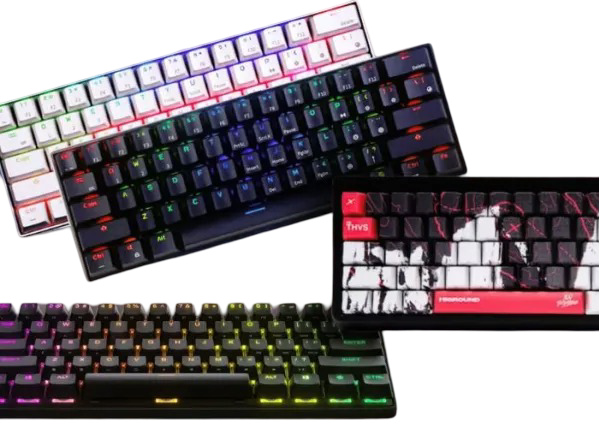Choosing the right keyboard is a crucial decision in today’s tech-driven landscape. The difference between a full-size and a tenkeyless (TKL) keyboard often comes down to specific needs, efficiency, and preference. Whether you’re a gamer, professional, or typist, selecting the perfect balance of functionality and design can transform your computing experience.
A full-size keyboard features a complete layout, including a numeric keypad on the right side, making it ideal for data entry, spreadsheets, and various tasks. On the other hand, TKL keyboards omit the keypad, resulting in a more compact, sleeker, and space-saving option. Understanding the nuances between these styles will ensure an informed decision that aligns with your workflow and requirements.
Choosing Between TKL and Full-Size Keyboards Made Easy

TKL vs. Full-Size: Key Differences
A full-size keyboard typically consists of 104 keys, whereas a TKL keyboard has around 87 keys, eliminating bulk by trimming unnecessary sections. This reduction in size makes TKL keyboards more portable and ergonomic, allowing closer positioning of the mouse, which is beneficial for both gaming battles and long typing sessions.
The functionality of a full-size keyboard includes a dedicated numeric keypad, essential for accountants, analysts, and those handling data-heavy tasks. Meanwhile, TKL keyboards cater to gamers and professionals who prioritize a compact workspace, enabling quick access to responsive keys without compromising on performance.
Advantages of TKL Keyboards
Ergonomics & Space-Saving
By reducing bulk, TKL keyboards allow for a more natural hand position, minimizing strain on the shoulder, arm, and muscles. This ergonomic advantage makes them an excellent tool for writers, programmers, and those who spend hours at a computer. The sleeker design also promotes an uncluttered environment, allowing for enhanced focus and creativity.
Gaming & Portability
For gamers, a TKL keyboard offers improved mouse positioning, ensuring quicker reflexes and precise movements during intense gaming sessions. The reduction in width also makes it ideal for LAN parties and frequent travelers, as it fits easily in bags and backpacks. This space-saving aspect enhances both gaming performance and workspace organization.
Disadvantages of TKL Keyboards
Lack of a Numeric Keypad
A major drawback of TKL keyboards is the absence of a numeric pad, which can be a significant limitation for users who frequently navigate spreadsheets, handle financial data, or perform calculations. This missing feature can impact data entry efficiency, making full-size keyboards indispensable for finance professionals and data-centric workflows.
Fewer Macro & Media Key Options
Another inconvenience of TKL keyboards is the missing dedicated multimedia keys, requiring users to rely on function key combinations. While some customizable options exist, they may not offer the same level of convenience as a full-size keyboard, particularly for those accustomed to traditional configurations.
Full-Size Mechanical Keyboards: Features & Benefits
Comprehensive Layout for Productivity
The full-size keyboard remains a pivotal tool for users who require a complete set of keys, including function keys, navigation cluster, and numeric keypad. This all-in-one design is particularly beneficial for office environments, report integration, and other data-heavy routines, ensuring seamless accuracy with every keystroke.
Enhanced Versatility for Gaming & Professional Use
For professionals handling complex reports, databases, and finance applications, the extended layout of a full-size keyboard offers speed, precision, and streamlined inputs. Likewise, gamers who juggle diverse macros will appreciate the dedicated keys, which can be customized for a more efficient workflow.
Disadvantages of Full-Size Keyboards
Bulky Design & Space Constraints
While a full-size keyboard provides maximum functionality, it also occupies more desk space, which may not be ideal for tight setups. The spacious positioning of the keys can lead to prolonged movement, which may not align with ergonomic principles, impacting comfort during long sessions.
Portability & Cost Considerations
A full-size keyboard is rarely a preferred option for those who frequently move between workstations or attend gaming events. It also tends to be more expensive than a TKL keyboard, especially when equipped with advanced features like wireless models, backlighting, and customization options. Additionally, it increases energy consumption, making it a less efficient choice for minimalist setups.

Key Considerations When Choosing a Keyboard
Mechanical Switch Type & Build Quality
A keyboard’s tactile feedback, key travel, and responsiveness largely depend on the type of mechanical switch used. Whether you prefer clicky, linear, or tactile switches, the choice should align with your specific preferences for gaming, typing, or professional tasks. Additionally, high-quality keycaps and durable construction ensure longevity and efficient usage.
Additional Features & Customizability
For users who seek customization, factors like programmable keys, RGB lighting, and wireless connectivity play a crucial role. The inclusion of macro shortcuts and media functions can impact efficiency, particularly for gamers and multimedia professionals. However, these features can drive up costs, making budget-conscious buyers opt for a simpler solution.
Understanding Full-Size vs. Tenkeyless (TKL) Keyboards
In the fast-paced world of technology, selecting the right keyboard is a crucial decision that impacts efficiency, comfort, and productivity. A full-size keyboard includes a numeric keypad on the right side, making it an ideal tool for accountants, analysts, and professionals working with data-heavy reports. On the other hand, a tenkeyless (TKL) keyboard omits the keypad, resulting in a compact design that saves space and improves ergonomics.
The key differences between these two keyboards lie in their layout, functionality, and portability. A full-size keyboard has 104 keys, offering a comprehensive layout for various tasks. In contrast, a TKL keyboard trims unnecessary bulk, eliminating extra keys to create a sleeker, space-saving option. The spacious positioning of a full-size keyboard can lead to prolonged strain, whereas a TKL keyboard promotes a natural position, reducing strain on the shoulder, arm, and muscles.
For gamers, the closer positioning of the mouse with a TKL keyboard provides improved responsiveness, making it a game-changer during intense gaming sessions. Writers and programmers also appreciate the ergonomic advantage of a compact keyboard, especially when spending hours on the computer. However, professionals who rely on rapid data entry, calculations, and spreadsheets may find the absence of a numeric keypad a drawback.
The decision between a full-size and TKL keyboard ultimately depends on individual preference, workflow requirements, and computing experience. Whether prioritizing portability, gaming performance, or office efficiency, choosing the right keyboard can transform the way users interact with their digital workspace.
Which One is Right for You?
Who Should Choose a TKL Keyboard?
If you prioritize portability, a sleeker design, and an ergonomic advantage, a TKL keyboard is the ideal choice. It’s a game-changer for gamers, programmers, and those who prefer a streamlined, uncluttered setup. With its minimalist approach, a TKL keyboard allows for better wrist positioning, reducing strain over prolonged computing sessions.
Who Should Choose a Full-Size Keyboard?
A full-size keyboard is perfect for accountants, finance professionals, and users who rely on a dedicated numeric keypad for data entry and calculations. If familiarity, functionality, and comprehensive key access are paramount, then this traditional layout is the ultimate solution. The extended configuration provides an excellent experience, especially for those accustomed to legacy systems or multifunctional workstations.
People Also Asked about Full-Size vs Tenkeyless Keyboards
What is the main difference between a full-size and TKL Keyboard?
A full-size keyboard includes a numeric keypad, making it ideal for data entry and professional use, while a TKL keyboard removes it for a compact, space-saving design preferred by gamers and travelers.
Is a TKL keyboard better for gaming?
Yes, a TKL keyboard allows for better mouse positioning, providing improved responsiveness and enhanced precision, making it a game-changer for competitive gaming.
Who should choose a full-size keyboard?
A full-size keyboard is perfect for accountants, analysts, and those working with spreadsheets, calculations, and data-heavy tasks that require a numeric keypad.
Are TKL keyboards more Ergonomic?
Yes, a TKL keyboard promotes a natural wrist position, reducing strain on the shoulders and arms, making it ergonomically beneficial for long computing sessions.
Do TKL Keyboards lack important functions?
While they omit the numeric keypad, TKL keyboards often include programmable keys and macro functions, allowing users to customize their workflow and efficiency.

